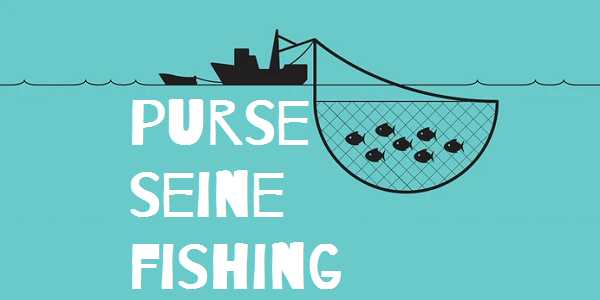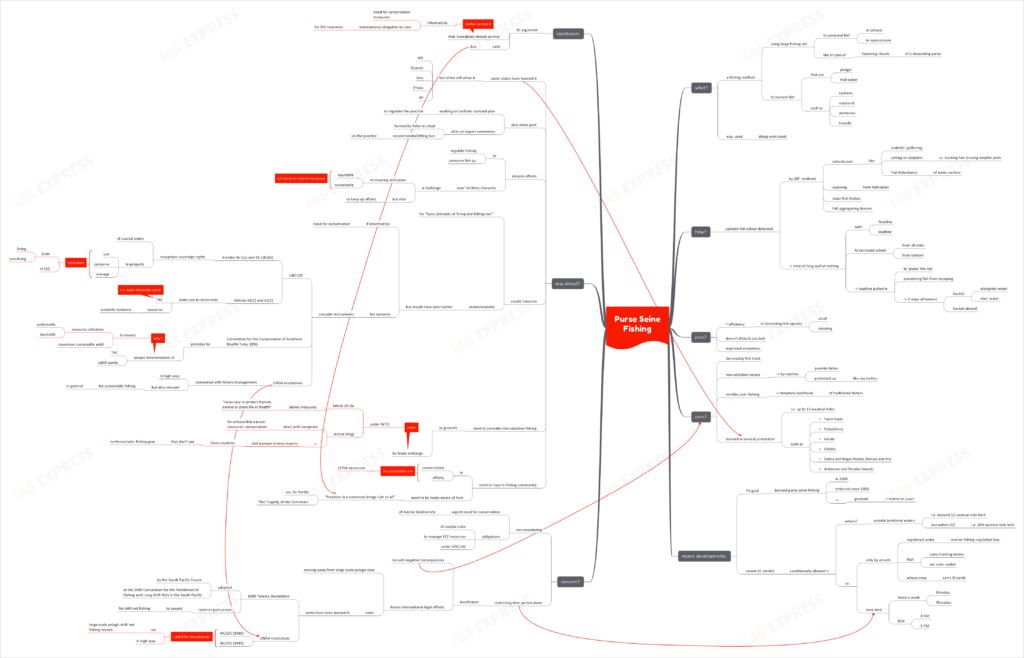Purse Seine Fishing- Pros, Cons & Recent SC Ruling

Recently, the Supreme Court gave conditional permission for purse seine fishing in Tamil Nadu. This comes at a time when the international legal mechanisms are moving away from such non-selective fishing methods.

This topic of “Purse Seine Fishing- Pros, Cons & Recent SC Ruling” is important from the perspective of the UPSC IAS Examination, which falls under General Studies Portion.
What is purse seine fishing?
- Purse seine fishing is a method of fishing in which a large vertical net is used to surround schools of fish in the open ocean and drawn in, in a manner similar to fastening of the chords in a drawstring purse.
- This method is used to harvest pelagic or midwater fish species en mass. Examples include sardines, mackerel, anchovies and trevally.
- This method is widely used along the western coast of India.
How is it done?
- Detection of a suitable school of fish is the 1st step. This is achieved using:
- Natural cues, like gathering of seabirds, “setting on dolphins” (i.e. tracking fast moving dolphin pods), increased disturbance of water surface, etc.
- Scanning the waters from a helicopter
- Use of radar fish finders
- Use of Fish Aggregating Devices
- A long wall of netting with a floatline and leadline is introduced into the target spot. It is used to surround the school from all the sides and from the bottom.
- Once surrounded, the leadline is pulled in to ‘purse’ the net, preventing the fish stock from escaping.
- The catch is then hauled aboard by the fishing vessel. In case of larger catches, the vessel pulls it alongside through the water towards the shore.
What are the pros?
- It is highly efficient in harvesting small shoaling fish varieties.
- It doesn’t disturb the sea bed.
- It increases economics of fishing activity.
What are the cons?
- It is associated with decreasing stock of fish species that inhabit the pelagic zone and exhibit shoaling behaviour.
- Its non-selective nature means it results in by-catches, including juvenile fishes.
- By-catches could include protected species. This includes sea turtles.
- It enables over-fishing, thus threatening the livelihood of traditional fishers.
- Notably, this practice is banned in several jurisdictions (up to 12 nautical miles):
- Tamil Nadu
- Puducherry
- Kerala
- Odisha
- Dadra and Nagar Haveli, Daman and Diu
- Andaman and Nicobar Islands
Recent Developments:
- The Tamil Nadu fisheries department banned purse seine fishing in its territorial waters in 2000. It began enforcing the ban seriously from 2020 onwards.
- The move led to protests in the state. The matter eventually ended up in the courts.
- Recently, the Supreme Court recently allowed this practice outside (i.e. beyond the 12-nautical-mile limit) TN’s territorial waters, but within the EEZ (200 nautical miles limit), saying “everybody should survive”.
- Note that this permission is conditional:
- Purse seine fishing is allowed only for vessels that are registered under the marine fishing regulation law.
- These vessels are to carry tracking devices.
- The vessels are also to be color coded.
- The vessels’ crew are to mandatorily carry ID cards.
- It is to be carried out only twice a week- on Monday and Thursday.
- It is to be carried out only between 8 AM and 6 PM.
Why is this concerning?
- Critics argue that by permitting purse seine fishing, the court is not considering the urgent need for marine biodiversity conservation efforts.
- The coastal states have an obligation to sustainably manage its EEZ under the UNCLOS framework.
- Merely restricting the time period is insufficient in curbing the negative consequences of the practice.
- This is why international legal efforts are moving away from large-scale pelagic nets. Several regional organizations have already banned the use of large drift nets.
- For instance, the 1989 Tarawa Declaration:
- The Tarawa Declaration was adopted by the South Pacific Forum at the 1989 Convention for the Prohibition of Fishing with Long Drift Nets in the South Pacific.
- It even restricts port access for vessels that seek to carry out drift net fishing.
- UNGA forum:
- Resolutions 44/225 (1989) and 46/215 (1991) called for moratorium on large-scale pelagic drift net fishing vessels in high seas.
- For instance, the 1989 Tarawa Declaration:
What is the way ahead?
- While some coastal states have already banned purse seine fishing, other states like West Bengal, Gujarat, Goa, Karnataka and Andhra Pradesh continue to allow this practice.
- Meanwhile, the union government is working on a uniform national plan to regulate purse seine fishing. Notably, an expert panel, constituted by the fisheries department, recommended lifting the ban on purse seine fishing.
- It is true that despite the best efforts to regulate fishing and conserve fish species, the seas’ limitless character poses and will continue to pose a challenge in ensuring equitable and sustainable utilization of common marine resources. However, it is vital that these efforts continue.
- While the court’s concern for the “basic principle of ‘living and letting live’” is understandable, it would have been better if its verdict were also guided by necessity of making fishing sustainable. Here, several international instruments can provide guidance:
- UNCLOS:
- Articles 56.1(a) and 56.1(b)(iii) recognize the coastal states’ sovereign rights to ensure the proper use, conservation and management of resources, both living and non-living, in the EEZs.
- It also highlights the states’ responsibility in preventing overexploitation of these resources. In line with this, Articles 61(1) and 61(2) hold that the states are to determine the TAC (total allowable catch) based on scientific evidence.
- Convention for the Conservation of Southern Bluefin Tuna, 1993:
- Provides for proper determination of TAC and catch quotas among the states party to the convention.
- This enables sustainable and equitable utilization of resources while ensuring maximum sustainable yield.
- UNCLOS:
- While the UNGA resolutions and other conventions are concerned with fishery management in the high seas, its provisions are relevant for sustainable fishing practices in general.
- The court needs to consider non-selective fishing methods as grounds for trade embargo.
- WTO’s Article XX (b) allows states to take such measures “necessary to protect human, animal or plant life or health”.
- Also, in accordance with Article XX(g) which deals with exception for exhaustible natural resources’ conservation, USA prohibited shrimp imports from countries that didn’t deploy turtle-excluder fishing gear.
- The fishing community needs to be made a stakeholder in the conversation and efforts surrounding the conservation and sustainable utilization of fish resources. They must be made aware of how “freedom in a commons brings ruin to all”, as said by Garrett Hardin, in ‘The Tragedy of the Commons’.
Conclusion:
The Supreme Court’s reasoning that “everybody should survive” is a valid argument. However, like Hardin said, “freedom in a commons brings ruin to all”. The court’s final judgement would better serve the purpose of ‘everybody’s survival’ if it is informed by the need for conservation measures and the international obligation to care for the resources in the EEZs.
Practice Question for Mains:
What is purse seine fishing? What are the pros and cons of allowing this practice? (250 words)

